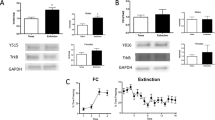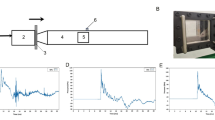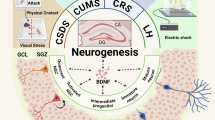Abstract
Compelling evidence suggests that mood disorders are characterized by reduced neuronal plasticity that might be normalized by pharmacological intervention. Our study aimed to establish whether chronic antidepressant treatment could alter the modulation of the neurotrophin brain-derived neurotrophic factor (BDNF) under a stressful condition. Therefore, adult male Sprague–Dawley rats were treated for 21 days with vehicle or with the SNRI duloxetine and, 24 h after the last injection, exposed to an acute swim stress (5 min) before being killed 15 min later. We found that chronic duloxetine treatment was able to modulate the rapid transcriptional changes of BDNF isoforms produced by an acute swim stress. Indeed whereas the mRNA levels of BDNF exon IV were upregulated by stress in vehicle as well as in duloxetine-treated rats, a significant increase of exon VI and exon IX was only found in rats that were pretreated with the antidepressant. These differential effects are in part because of selective changes in signaling pathways involved in the control of BDNF transcription. Moreover, the acute stressful episode significantly increased the levels of mature BDNF protein in the synaptosomal compartment in rats that were pretreated with the antidepressant, but not in control animals. Our results suggest that chronic antidepressant treatment might affect the responsiveness of BDNF under stressful conditions, suggesting that pharmacological intervention could ‘prime’ neuroprotective pathways and render them more responsive to preserve cell function and viability.
Similar content being viewed by others
Log in or create a free account to read this content
Gain free access to this article, as well as selected content from this journal and more on nature.com
or
References
Aid T, Kazantseva A, Piirsoo M, Palm K, Timmusk T (2007). Mouse and rat BDNF gene structure and expression revisited. J Neurosci Res 85: 525–535.
Berton O, Nestler EJ (2006). New approaches to antidepressant drug discovery: beyond monoamines. Nat Rev Neurosci 7: 137–151.
Bilang-Bleuel A, Ulbricht S, Chandramohan Y, De Carli S, Droste SK, Reul JM (2005). Psychological stress increases histone H3 phosphorylation in adult dentate gyrus granule neurons: involvement in a glucocorticoid receptor-dependent behavioural response. Eur J Neurosci 22: 1691–1700.
Bonanno G, Giambelli R, Raiteri L, Tiraboschi E, Zappettini S, Musazzi L et al (2005). Chronic antidepressants reduce depolarization-evoked glutamate release and protein interactions favoring formation of SNARE complex in hippocampus. J Neurosci 25: 3270–3279.
Bramham CR, Messaoudi E (2005). BDNF function in adult synaptic plasticity: the synaptic consolidation hypothesis. Prog Neurobiol 76: 99–125.
Budziszewska B (2002). Effect of antidepressant drugs on the hypothalamic–pituitary–adrenal axis activity and glucocorticoid receptor function. Pol J Pharmacol 54: 343–349.
Calabrese F, Molteni R, Maj PF, Cattaneo A, Gennarelli M, Racagni G et al (2007). Chronic duloxetine treatment induces specific changes in the expression of BDNF transcripts and in the subcellular localization of the neurotrophin protein. Neuropsychopharmacology 32: 2351–2359.
Castren E (2005). Is mood chemistry? Nat Rev Neurosci 6: 241–246.
Chen WG, Chang Q, Lin Y, Meissner A, West AE, Griffith EC et al (2003). Derepression of BDNF transcription involves calcium-dependent phosphorylation of MeCP2. Science 302: 885–889.
Chiaruttini C, Sonego M, Baj G, Simonato M, Tongiorgi E (2008). BDNF mRNA splice variants display activity-dependent targeting to distinct hippocampal laminae. Mol Cell Neurosci 37: 11–19.
Coppell AL, Pei Q, Zetterstrom TS (2003). Bi-phasic change in BDNF gene expression following antidepressant drug treatment. Neuropharmacology 44: 903–910.
Duman CH, Schlesinger L, Kodama M, Russell DS, Duman RS (2007). A role for MAP kinase signaling in behavioral models of depression and antidepressant treatment. Biol Psychiatry 61: 661–670.
Duman RS (2002). Pathophysiology of depression: the concept of synaptic plasticity. Eur Psychiatry 17 (Suppl 3): 306–310.
Duman RS, Monteggia LM (2006). A neurotrophic model for stress-related mood disorders. Biol Psychiatry 59: 1116–1127.
Dwivedi Y, Rizavi HS, Pandey GN (2006). Antidepressants reverse corticosterone-mediated decrease in brain-derived neurotrophic factor expression: differential regulation of specific exons by antidepressants and corticosterone. Neuroscience 139: 1017–1029.
Fumagalli F, Molteni R, Calabrese F, Frasca A, Racagni G, Riva MA (2005). Chronic fluoxetine administration inhibits extracellular signal-regulated kinase 1/2 phosphorylation in rat brain. J Neurochem 93: 1551–1560.
Groves JO (2007). Is it time to reassess the BDNF hypothesis of depression? Mol Psychiatry 12: 1079–1088.
Hansson AC, Sommer WH, Metsis M, Stromberg I, Agnati LF, Fuxe K (2006). Corticosterone actions on the hippocampal brain-derived neurotrophic factor expression are mediated by exon IV promoter. J Neuroendocrinol 18: 104–114.
Joels M, Krugers H, Karst H (2008). Stress-induced changes in hippocampal function. Prog Brain Res 167: 3–15.
Kozisek ME, Middlemas D, Bylund DB (2008). Brain-derived neurotrophic factor and its receptor tropomyosin-related kinase B in the mechanism of action of antidepressant therapies. Pharmacol Ther 117: 30–51.
Lauterborn JC, Rivera S, Stinis CT, Hayes VY, Isackson PJ, Gall CM (1996). Differential effects of protein synthesis inhibition on the activity-dependent expression of BDNF transcripts: evidence for immediate–early gene responses from specific promoters. J Neurosci 16: 7428–7436.
Liu QR, Lu L, Zhu XG, Gong JP, Shaham Y, Uhl GR (2006). Rodent BDNF genes, novel promoters, novel splice variants, and regulation by cocaine. Brain Res 1067: 1–12.
Marmigere F, Givalois L, Rage F, Arancibia S, Tapia-Arancibia L (2003). Rapid induction of BDNF expression in the hippocampus during immobilization stress challenge in adult rats. Hippocampus 13: 646–655.
Martinowich K, Manji H, Lu B (2007). New insights into BDNF function in depression and anxiety. Nat Neurosci 10: 1089–1093.
McClung CA, Nestler EJ (2008). Neuroplasticity mediated by altered gene expression. Neuropsychopharmacology 33: 3–17.
McEwen BS (2007). Physiology and neurobiology of stress and adaptation: central role of the brain. Physiol Rev 87: 873–904.
Molteni R, Calabrese F, Bedogni F, Tongiorgi E, Fumagalli F, Racagni G et al (2006). Chronic treatment with fluoxetine up-regulates cellular BDNF mRNA expression in rat dopaminergic regions. Int J Neuropsychopharmacol 9: 307–317.
Molteni R, Calabrese F, Ghourbaji S, Brandwein C, Racagni G, Gass P et al (2008). Depression-prone mice with reduced glucocorticoid receptor expression display an altered stress-dependent regulation of brain-derived neurotrophic factor (BDNF) and activity-regulated cytoskeleton associated protein (ARC). J of Psychopharmacology, in press.
Nair A, Vadodaria KC, Banerjee SB, Benekareddy M, Dias BG, Duman RS et al (2007). Stressor-specific regulation of distinct brain-derived neurotrophic factor transcripts and cyclic AMP response element-binding protein expression in the postnatal and adult rat hippocampus. Neuropsychopharmacology 32: 1504–1519.
Nibuya M, Morinobu S, Duman RS (1995). Regulation of BDNF and trkB mRNA in rat brain by chronic electroconvulsive seizure and antidepressant drug treatments. J Neurosci 15: 7539–7547.
Pariante CM (2003). Depression, stress and the adrenal axis. J Neuroendocrinol 15: 811–812.
Pariante CM, Kim RB, Makoff A, Kerwin RW (2003). Antidepressant fluoxetine enhances glucocorticoid receptor function in vitro by modulating membrane steroid transporters. Br J Pharmacol 139: 1111–1118.
Pariante CM, Miller AH (2001). Glucocorticoid receptors in major depression: relevance to pathophysiology and treatment. Biol Psychiatry 49: 391–404.
Pariante CM, Pearce BD, Pisell TL, Owens MJ, Miller AH (1997). Steroid-independent translocation of the glucocorticoid receptor by the antidepressant desipramine. Mol Pharmacol 52: 571–581.
Pattabiraman PP, Tropea D, Chiaruttini C, Tongiorgi E, Cattaneo A, Domenici L (2005). Neuronal activity regulates the developmental expression and subcellular localization of cortical BDNF mRNA isoforms in vivo. Mol Cell Neurosci 28: 556–570.
Pittenger C, Duman RS (2008). Stress, depression, and neuroplasticity: a convergence of mechanisms. Neuropsychopharmacology 33: 88–109.
Rangarajan PN, Umesono K, Evans RM (1992). Modulation of glucocorticoid receptor function by protein kinase A. Mol Endocrinol 6: 1451–1457.
Roceri M, Cirulli F, Pessina C, Peretto P, Racagni G, Riva MA (2004). Postnatal repeated maternal deprivation produces age-dependent changes of brain-derived neurotrophic factor expression in selected rat brain regions. Biol Psychiatry 55: 708–714.
Saarelainen T, Hendolin P, Lucas G, Koponen E, Sairanen M, MacDonald E et al (2003). Activation of the TrkB neurotrophin receptor is induced by antidepressant drugs and is required for antidepressant-induced behavioral effects. J Neurosci 23: 349–357.
Schaaf MJ, De Kloet ER, Vreugdenhil E (2000). Corticosterone effects on BDNF expression in the hippocampus. Implications for memory formation. Stress 3: 201–208.
Schloss P, Henn FA (2004). New insights into the mechanisms of antidepressant therapy. Pharmacol Ther 102: 47–60.
Sheline YI, Mittler BL, Mintun MA (2002). The hippocampus and depression. Eur Psychiatry 17 (Suppl 3): 300–305.
Smith MA, Makino S, Kvetnansky R, Post RM (1995). Stress and glucocorticoids affect the expression of brain-derived neurotrophic factor and neurotrophin-3 mRNAs in the hippocampus. J Neurosci 15: 1768–1777.
Stockmeier CA, Mahajan GJ, Konick LC, Overholser JC, Jurjus GJ, Meltzer HY et al (2004). Cellular changes in the postmortem hippocampus in major depression. Biol Psychiatry 56: 640–650.
Tabuchi A, Nakaoka R, Amano K, Yukimine M, Andoh T, Kuraishi Y et al (2000). Differential activation of brain-derived neurotrophic factor gene promoters I and III by Ca2+ signals evoked via L-type voltage-dependent and N-methyl-D-aspartate receptor Ca2+ channels. J Biol Chem 275: 17269–17275.
Tabuchi A, Sakaya H, Kisukeda T, Fushiki H, Tsuda M (2002). Involvement of an upstream stimulatory factor as well as cAMP-responsive element-binding protein in the activation of brain-derived neurotrophic factor gene promoter I. J Biol Chem 277: 35920–35931.
Takeuchi Y, Miyamoto E, Fukunaga K (2002). Analysis on the promoter region of exon IV brain-derived neurotrophic factor in NG108-15 cells. J Neurochem 83: 67–79.
Takeuchi Y, Yamamoto H, Miyakawa T, Miyamoto E (2000). Increase of brain-derived neurotrophic factor gene expression in NG108-15 cells by the nuclear isoforms of Ca2+/calmodulin-dependent protein kinase II. J Neurochem 74: 1913–1922.
Tao X, West AE, Chen WG, Corfas G, Greenberg ME (2002). A calcium-responsive transcription factor, CaRF, that regulates neuronal activity-dependent expression of BDNF. Neuron 33: 383–395.
Tardito D, Perez J, Tiraboschi E, Musazzi L, Racagni G, Popoli M (2006). Signaling pathways regulating gene expression, neuroplasticity, and neurotrophic mechanisms in the action of antidepressants: a critical overview. Pharmacol Rev 58: 115–134.
Tongiorgi E, Righi M, Cattaneo A (1997). Activity-dependent dendritic targeting of BDNF and TrkB mRNAs in hippocampal neurons. J Neurosci 17: 9492–9505.
Tsankova NM, Berton O, Renthal W, Kumar A, Neve RL, Nestler EJ (2006). Sustained hippocampal chromatin regulation in a mouse model of depression and antidepressant action. Nat Neurosci 9: 519–525.
Wyneken U, Sandoval M, Sandoval S, Jorquera F, Gonzalez I, Vargas F et al (2006). Clinically relevant doses of fluoxetine and reboxetine induce changes in the TrkB content of central excitatory synapses. Neuropsychopharmacology 31: 2415–2423.
Zhou Z, Hong EJ, Cohen S, Zhao WN, Ho HY, Schmidt L et al (2006). Brain-specific phosphorylation of MeCP2 regulates activity-dependent BDNF transcription, dendritic growth, and spine maturation. Neuron 52: 255–269.
Acknowledgements
Special thanks to Dr J Richetto for contributing to part of this study and to Professor ME Greenberg for the generous gift of MeCP2 antibodies. This research has been supported by funding to MAR from the Italian Ministry of University and Research (PRIN2005 n. 2005059982), the Ministry of Health, and by an unrestricted grant from Eli Lilly Italia SpA.
Author information
Authors and Affiliations
Corresponding author
Additional information
DISCLOSURE/CONFLICT OF INTEREST
All authors have no financial interests or potential conflicts of interest to declare. Dr Michele Mancini is an employee of Eli Lilly Italia holding Eli Lilly nonqualified stock option shares.
Rights and permissions
About this article
Cite this article
Molteni, R., Calabrese, F., Cattaneo, A. et al. Acute Stress Responsiveness of the Neurotrophin BDNF in the Rat Hippocampus is Modulated by Chronic Treatment with the Antidepressant Duloxetine. Neuropsychopharmacol 34, 1523–1532 (2009). https://doi.org/10.1038/npp.2008.208
Received:
Revised:
Accepted:
Published:
Issue date:
DOI: https://doi.org/10.1038/npp.2008.208
Keywords
This article is cited by
-
Modulation of DNA Methylation and Gene Expression in Rodent Cortical Neuroplasticity Pathways Exerts Rapid Antidepressant-Like Effects
Molecular Neurobiology (2021)
-
Exploratory study on neurochemical effects of low-intensity pulsed ultrasound in brains of mice
Medical & Biological Engineering & Computing (2021)
-
Combination of syringaresinol–di–O–β-d-glucoside and chlorogenic acid shows behavioral pharmacological anxiolytic activity and activation of hippocampal BDNF–TrkB signaling
Scientific Reports (2020)
-
Acute Stress Induces Cognitive Improvement in the Novel Object Recognition Task by Transiently Modulating Bdnf in the Prefrontal Cortex of Male Rats
Cellular and Molecular Neurobiology (2020)
-
Chronic treatment with the antipsychotic drug blonanserin modulates the responsiveness to acute stress with anatomical selectivity
Psychopharmacology (2020)



